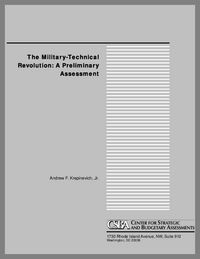
FOREWORD
This net assessment of the military-technical revolution, issued in July of 1992, is perhaps the best-known assessment prepared by the Office of Net Assessment. It has, I believe, held up well over time. The strategic management issues it raised should still be of special interest to top-level Department of Defense officials.
Why was the assessment undertaken in the first place? The history is as follows: During the mid to late-1970s my office had picked up on the writings and other actions by the Soviet military which suggested that they believed a period of major change in warfare had begun. At that time it was the United States that was laying the groundwork for the revolution, but it was the Soviet military theorists, rather than our own, that were intellectualizing about it, and speculating on the longer-term consequences of the technical and other changes that the American military had initiated. As the Soviets appeared very concerned about these developments, we concluded that it would be useful to intensify those concerns by further investment in the “reconnaissance-strike complexes” (as the Soviets called them) that were central to their vision of how future warfare would change.
Later, as part of the Commission on Integrated Long-Term Strategy that Fred Iklé and Albert Wohlstetter led during the mid-1980s, Charles Wolf and I co-chaired the “Future Security Environment Working Group” which had been asked to look ahead twenty years and provide an assessment of the geopolitical and technical changes on which United States military planners ought to focus their attention. We recommended three likely changes for special attention. One was that the next twenty years would be a period of major change in warfare.
So it was in late 1990 or perhaps early 1991, shortly after Andrew Krepinevich had joined the office, that I asked him to undertake an assessment to decide still more clearly if we really believed that the Soviet theorists were correct in their belief that technological developments would lead to major changes in warfare. I believed that if we were in such a period, then senior Defense officials would be faced with new, important strategic management issues. The purpose of the assessment, then, was to clarify and highlight what we thought were the most important of these strategic management issues. The assessment raised four:
- How to identify appropriate innovations? (Perhaps, by means of future oriented war games, field exercises, forming experimental units, etc.)
- How to foster innovation? (Perhaps, by changes in career programs—introducing new career paths—military education, protecting and promoting innovative officers, etc.)
- How to change the DoD acquisition process better to support field experimentation? (Perhaps by facilitating procurement of small numbers of new equipment for experimental or prototype units, etc.)
- How to involve our allies? What role would they play? What would be the new division of labor between us?
This assessment is not typical of the assessments produced by the Office of Net Assessment. Nor was the process by which it was conducted like that of other assessments. For example, because of its nature the assessment had very little to do with classified information. It dealt with speculation about the future, and the potential impact of technology and new operational concepts on warfare. Rather than drawing upon a small group or single individual, many panels were formed to discuss the various issues. This process was consciously chosen in the hope that it would produce a shared language and vocabulary for discussing the character of the changes in warfare that might take place in the future. The effort yielded what seemed to be a consensus that we were in a period of major change; in short, that the Russian theorists were right. We also concluded from military history that changes of the scale that we were talking about would involve new concepts of operation, and new organizational structures and processes to execute these concepts.
The assessment draws upon analogies with a previous period of major change in warfare, the 1920s and the 1930s, to specify the scale of the change we anticipated. This period also seemed of special interest because the institutional and other arrangements within the United States military are still reasonably close to those of that period. It was hoped, therefore, that we might learn lessons about successful strategies of innovation from studies of the best performance of United States military organizations.
We live in a period of large scale, rapid technological and, very likely, social change. The pace of technological change is accelerating. We have not fully exploited and adjusted to developments in information and communication technologies; the next wave of change-producing developments is coming out of the biological and human sciences, which are likely to become significant sources of change in military operations and organizations. These developments only reinforce the importance of the strategic management issues that were raised in this assessment.
Andrew W. Marshall
September 2002



























